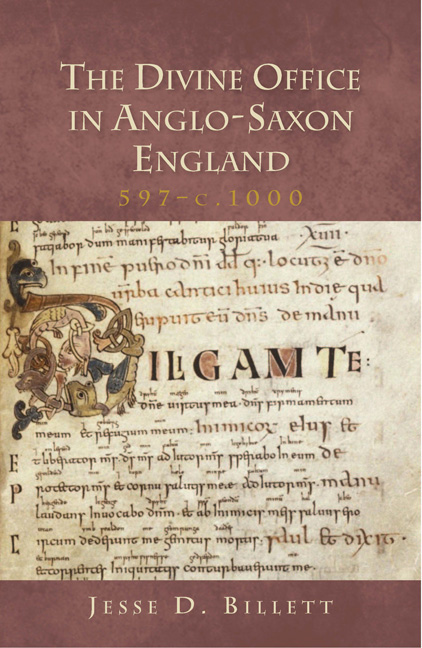Book contents
- Frontmatter
- Dedication
- Contents
- TABLES
- ILLUSTRATIONS
- PREFACE
- NOTE ON USAGE
- ABBREVIATIONS
- MANUSCRIPT SIGLA
- Part I The Historical Development of the Divine Office in England to c.1000
- 1 TOWARDS A ‘NEW NARRATIVE’ OF THE HISTORY OF THE DIVINE OFFICE IN ANGLO-SAXON ENGLAND
- 2 THE DIVINE OFFICE IN THE LATIN WEST IN THE EARLY MIDDLE AGES
- 3 THE DIVINE OFFICE IN ENGLAND FROM THE AUGUSTINIAN MISSION TO THE FIRST VIKING INVASIONS, 597–c.835
- 4 THE DIVINE OFFICE IN ENGLAND FROM THE FIRST VIKING AGE TO THE ABBACY OF DUNSTAN AT GLASTONBURY, c.835–c.940
- 5 THE DIVINE OFFICE AND THE TENTH-CENTURY ENGLISH BENEDICTINE REFORM
- Part II Manuscript Evidence for English Office Chant in the Tenth Century
- Appendices
- BIBLIOGRAPHY
- INDEX OF MANUSCRIPTS
- INDEX OF LITURGICAL FORMS
- INDEX OF BIBLICAL REFERENCES AND LITURGICAL READINGS
- GENERAL INDEX
1 - TOWARDS A ‘NEW NARRATIVE’ OF THE HISTORY OF THE DIVINE OFFICE IN ANGLO-SAXON ENGLAND
from Part I - The Historical Development of the Divine Office in England to c.1000
Published online by Cambridge University Press: 05 November 2014
- Frontmatter
- Dedication
- Contents
- TABLES
- ILLUSTRATIONS
- PREFACE
- NOTE ON USAGE
- ABBREVIATIONS
- MANUSCRIPT SIGLA
- Part I The Historical Development of the Divine Office in England to c.1000
- 1 TOWARDS A ‘NEW NARRATIVE’ OF THE HISTORY OF THE DIVINE OFFICE IN ANGLO-SAXON ENGLAND
- 2 THE DIVINE OFFICE IN THE LATIN WEST IN THE EARLY MIDDLE AGES
- 3 THE DIVINE OFFICE IN ENGLAND FROM THE AUGUSTINIAN MISSION TO THE FIRST VIKING INVASIONS, 597–c.835
- 4 THE DIVINE OFFICE IN ENGLAND FROM THE FIRST VIKING AGE TO THE ABBACY OF DUNSTAN AT GLASTONBURY, c.835–c.940
- 5 THE DIVINE OFFICE AND THE TENTH-CENTURY ENGLISH BENEDICTINE REFORM
- Part II Manuscript Evidence for English Office Chant in the Tenth Century
- Appendices
- BIBLIOGRAPHY
- INDEX OF MANUSCRIPTS
- INDEX OF LITURGICAL FORMS
- INDEX OF BIBLICAL REFERENCES AND LITURGICAL READINGS
- GENERAL INDEX
Summary
This book is about the Divine Office and its performance in Anglo-Saxon England. The Divine Office comprises the several non-sacramental services of psalmody, lections, and prayers recited daily by religious communities (usually of monks, nuns, or canons), and by individuals otherwise bound to do so. Unlike research into the Mass, work on the Divine Office has historically been the preserve of priests and religious, intended for a clerical audience. In recent decades, however, a number of important studies and research tools have appeared that have made the Office more accessible to the wider scholarly community. Research on the Divine Office in Anglo-Saxon England has enjoyed the benefit of earlier scholars' dedication to the production of authoritative and accessible editions of English liturgical manuscripts. Apart from editions, the literature has fallen largely into two categories: ‘descriptive’ studies, concerned with the cataloguing and editing of texts and the identification of references to the Office in narrative sources and booklists, and ‘functional’ studies, exploring how the Office can provide the key to the correct interpretation of material not itself directly connected with the performance of the liturgy (such as vernacular literary works).
The study of the Office in Anglo-Saxon England has been largely contained to the tenth and eleventh centuries, the period best attested in surviving manuscripts. Most of these manuscripts (and they are largely fragmentary) present the liturgical situation in England in the wake of the Benedictine reform movement of the second half of the tenth century.
- Type
- Chapter
- Information
- The Divine Office in Anglo-Saxon England, 597-c.1000 , pp. 3 - 12Publisher: Boydell & BrewerPrint publication year: 2014



